Bhutan, the land of the Thunder Dragon is no ordinary place. This is a country with much amazement. This is a country where rice is red, people have a love affair with chillies, landscapes are untouched and vibes are peaceful.
It is also a Buddhist land where monks are extremely friendly and people are at all times happy. Bhutan is the only carbon negative country in the world.
It is this perfect blend of ancient and modern, makes Bhutan extremely fascinating.
OVERVIEW
Which region of Bhutan you decide to explore will depend upon how much time you can afford to spend and your budget.
The vast majority of tourists concentrates on the west and Thimphu.
HOW TO REACH BHUTAN FROM INDIA
1. BY AIR
The Paro International Airport is the only international airport in Bhutan. There are limited options for travelling via air.
The specific airlines that are permitted to operate flights into and out of Bhutan are the national carriers, Druk Air and Bhutan Airlines.
Druk Air flies in and out of Bhutan from the following cities of India:
- Delhi (DEL – India)
- Mumbai (BOM – India)
- Kolkata (CCU – India)
- Bagdogra (IXB – India)
- Gaya (GAY- India)
- Guwahati (GAU – India)
- Kathmandu (KTM – India).
Bhutan Airlines flies in and out of Bhutan from the following cities of India
- Delhi (DEL – India) and
- Kolkata (CCU – India).
2. BY TRAIN
Rail travel is the cheapest way to reach Bhutan from India. There are no direct trains to Bhutan.
Hasimara station, West Bengal is the closest railway station, about 17 km from Jaigaon-Phuentsholing border.
Trains run to Hasimara from Delhi, Kanpur and Kolkata regularly, with connections and changes.
3. BY ROAD
Travelling to Bhutan by road may be an expensive way especially if you’re travelling from far away from such as New Delhi, Hyderabad etc. However, if you are travelling from Kolkata, it may not be a bad idea.
Indian nationals can take their own cars to Bhutan. One needs to obtain a permit at the Regional Transport Office in Phuensholing for a fee of about INR 200.
THE BEST WAY TO REACH BHUTAN
The best way to reach Bhutan is to mix the above modes of transport. To save cost and time and to relish great scenery along the route, we suggest the following:
– Take a flight from your home destination and arrive at Bagdogra, West Bengal.
– After arriving at Bagdogra, travel to Phuensholing either by road (4 hours) or by train (change connections).
The advantage of flying into Bagdogra and travelling overland is that it cuts down on total cost and it allows you to explore some of the scenic landscapes, several rivers, tea gardens on your way to Bhutan!
SUMMARY OF BHUTAN ITINERARY
Day 1: Arrive in Bagdogra and travel to Phuentsholing, overnight at Pheuntsholing
Day 2: Travel to Thimphu, overnight at Thimphu
Day 3: Explore Thimphu, overnight at Thimphu
Day 4: Reach Punakha, overnight at Punakha
Day 5: Reach Paro, overnight at Paro
Day 6: Tiger’s Nest, overnight at Paro
Day 7: Take a flight back home.
DAY 1 OF BHUTAN ITINERARY
BAGDOGRA – PHEUNTSHOLING
Arrive at Bagdogra and travel to Phuentsholing.
The distance from Bagdogra to Phuentsholing is 163 km and the duration is 4 hours.
DAY 2 OF BHUTAN ITINERARY
THIMPHU

Rise and Shine! You’ll today experience the vibrant Bhutanese culture in Thimphu.
Thimphu is a beautiful colourful city in a tranquil landscape, with bright blue skies, green mountains and rice fields.
Leave in the morning and head to Immigration Office to get your passport stamped and start your journey towards Thimphu. The immigration office opens at 9 am. The brief details of the entry permit are mentioned at the end of this blog.
The drive to Thimphu, the capital of Bhutan, is about 5 hours (including the halts). Try to reach Thimphu by afternoon.
STROLLS AND HANDICRAFT MARKET
Stroll around the Thimphu city and visit the local handicraft market. There are lots of interesting Bhutanese products.
Do not miss visiting Norzin Lam, city’s main trail, wherein you’ll see dozens of craft stalls line the middle of Norzim Lam. It’s the single best place to shop for crafts with stalls selling everything from embroidered boots to handmade paper.
PRO TIPS
If you are here during the weekend then bingo! Plunge into Thimphu’s pungent and bustling “weekend market” for incense and artefacts.
If you are not keen to visit the market, visit Bhutan Postal Museum. Here, you can have customized postal stamps with your photo on it! Now, isn’t that awesome?
The postal museum is open from 10 am to 5 pm., every day.
Today, relax at a wonderful spot and enjoy sipping the traditional butter tea!
DAY 3 OF BHUTAN ITINERARY
THIMPHU

BUDDHA DORDENMA
The huge 51m-tall statue of Buddha Dordenma commands the entry to Thimphu! Located atop a hill in Kuenselphodrang Nature Park, Buddha Dordenma is a masterpiece of architectural wonders.
Interestingly, this giant Buddha statue has 12,500 smaller statues of Buddhas filled inside in it.
NATIONAL MEMORIAL CHORTEN
This Tibetan-style chorten is one of the most visible religious structures in Thimphu. Many people visit this Chorten every day to spin the prayer wheels.
CHANGANGKHA LHAKHANG
Established in the 12th century on a site chosen by Lama Phajo Drukgom Shigpo, this temple is perched like a fortress and is known to be the wish-filling temple. It is also one of the oldest temples in Thimphu.
NATIONAL INSTITUTE FOR ZORI CHUSUM
Commonly known as “the painting school”, offers a six-year course in Bhutan’s 13 traditional arts and crafts. The institute is a symbol of the ancient art of Bhutan, which comprises paintings, statues and so on.
TASHICHHO DZONG
One of the most popular landmarks in Thimphu, this splendid Buddhist monastery and fortress, seems to fit seamlessly into the valley. It is also popularly known as Thimphu Dzong.
It’s Thimphu’s grandest building so far, and it is the main secretariat building, which houses the offices of King and the Throne Room.
THE NATIONAL LIBRARY OF BHUTAN
This library was established in 1967 to preserve ancient Dzongkha and Tibetan texts. It houses some great historic photos, traditional books and historic manuscripts.
When at the National Library, DO NOT MISS to check out the copy of world’s largest published book!
POSTAL MUSEUM
If you have not visited this newly opened (2015) museum on the day of your arrival, visit this place today. Don’t miss to get your picture on Bhutanese stamp!
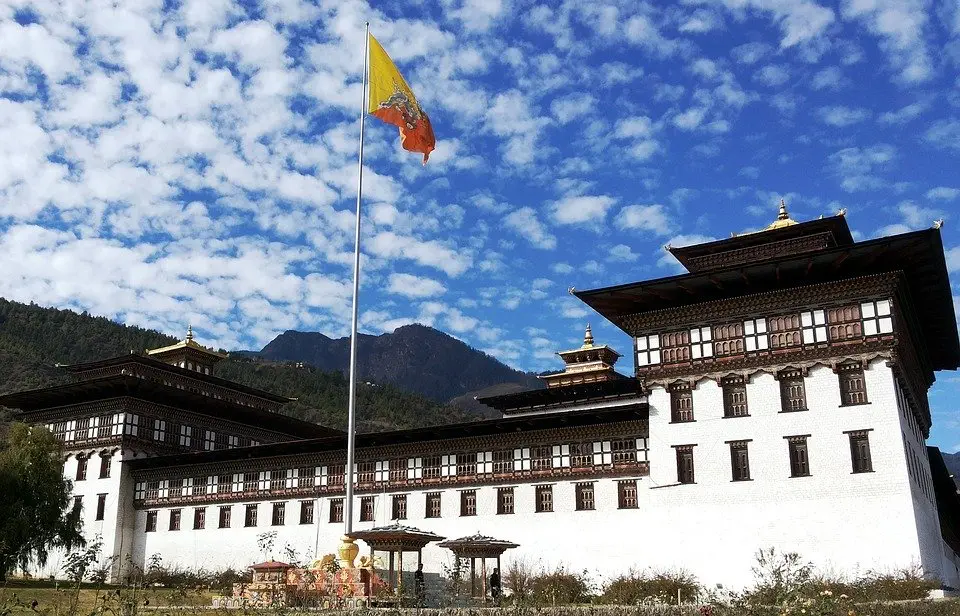
PRO TIPS
- During your stay in Thimphu, visit Zomabala for momos or the trendy Ambient Cafe or Karma’s Coffee for coffee and cake.
- As beer’o’ clock approaches head towards The Zone. For some entertainment or a club night, visit Mojo Park to catch a live Bhutanese band.
Most of the major attractions are already included above. Here are a few suggestions if you have an extra day in hand or free time:
- One of the best views of the Thimphu valley comes from Sangaygang viewpoint. This is below the popular Bhutan Broadcasting Service Tower (BBS Tower).
- If the weekend market isn’t on, visit Changlimithang Archery Ground or National Textile Museum.
DAY 4 OF BHUTAN ITINERARY
PUNAKHA
You’ll leave for Punakha. The distance to Punakha is about 83 km.
Punakha sits in a beautiful valley right at the juncture of Mo Chhu (Mother) river and Pho Chhu (Father) river.
The drive from Thimphu to Punakha, along the National Highway and over to Dochu La, leads from the lush landscapes.
PIT-STOPS ON THE WAY TO PUNAKHA
From Thimphu to Dochu La

1. Simtokha Dzong
From Thimphu, the route to the east leaves the road to Paro and loops back over itself to become the east-west national highway. You’ll find a good view of Simtokha Dzong.
The above route climbs through the apple orchards and forests of blue pine to the village Hongtsho (2890m), where an immigration checkpoint controls all access to eastern Bhutan. Your guide will present your travel permit and you will proceed further.
2. Dochu La
The road climbs to the Dochu La (3140m), the highlights being large prayer flags and striking collection of 108 chortens. These chorten collections were built in 2005 as atonements for the loss of lives of 108 Bhutanese soldiers that were caused by flushing out some insurgent groups in Bhutan.
3. Druk Wangyal Cafe
Do not miss “Druk Wangyal Cafe”, a popular spot for hot coffee and a warming bukhari.
4. Druk Wangyal Lhakhang
The adjacent Druk Wangyal Lhakhang is well worth a visit to view its cartoon-style modern murals.
5. Royal Botanical Park.
If botanical parks interest you, the hill above the chortens is covered in a lovely forest, which is a part of Royal Botanical Park. It’s a great place for bird watching and to witness blooms (between mid-March – April).
6. Chimi Lhakhang
As you move further to Punakha, the zigzag road passes a collection of restaurants, cafes, houses at Sopsokha, from where you can visit the yellow roof, Chimi Lhakhang, also known as The Fertility Temple of Bhutan.
It is indeed an interesting aspect of the cultural side of Bhutan. Chimi Lhakhang is a temple of “Diving Madman”. The Divine Madman was a Buddhist monk who loved alcohol and women.
Built-in 1499, it is now a temple of fertility and the childless couples visit this temple to receive a blessing. Moreover, newborns are also brought here to be named.
Most of the visitors take the 20-minute walk across the beautiful fields from the road at Sopsokha to the temple. The trail leads downhill across the rice fields and to a tiny settlement of Pana. The beautiful walk will blow your mind away!
Continue to heads towards Punakha.
Punakha Dzong
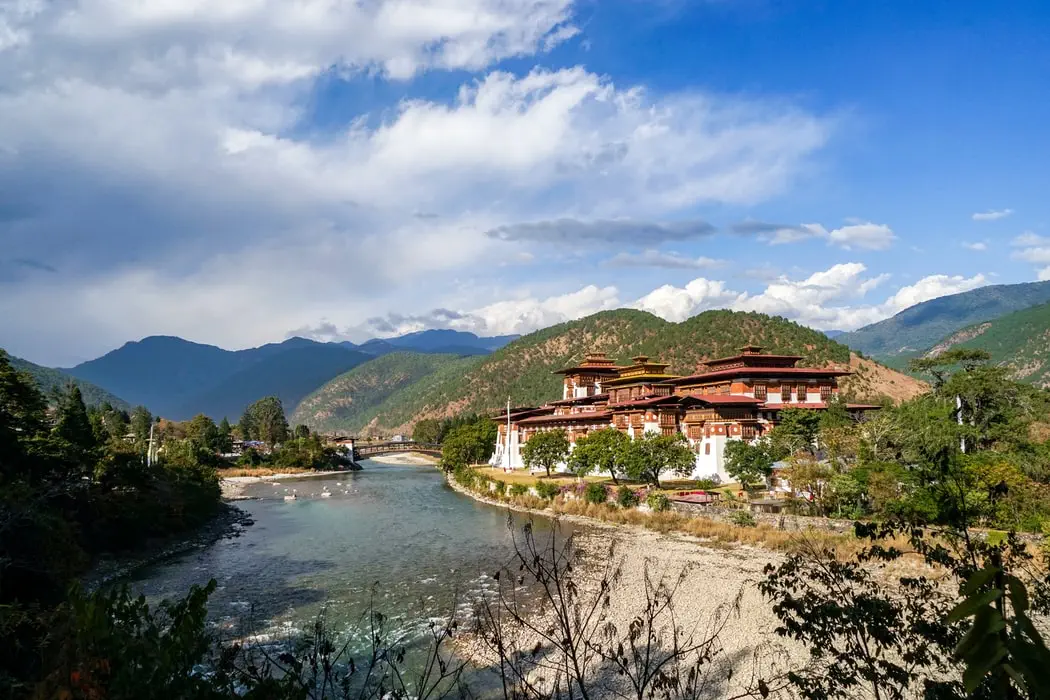
This is arguably the most beautiful dzong in the country. All of Bhutan’s kings have been crowned here.
Cross the wooden/suspension bridge to the fortress and spend time wandering the courtyard and admiring the vibrant woodwork.
PRO TIPS
White Water Rafting
If time permits and if you are in Punakha during springs, then do not miss white water rafting in Punakha.
The Khumsum Yuelly Namgyal Chorten bridge, about 6 km above Punakha Dzong, is a put-in spot for relaxing rafting and kayaking trips.
Off the beaten track
If you are looking for some off the beaten track then visit Gasa Dzong.
Gasa is the most northern district in Bhutan. A three-hour ride from Punakha, this beautiful area is meant for adventurous folks.
The full Gasa district is an environmentally protected area of Bhutan, with Jigme Dorji National Park being the jewel of the region.
The rewards of visiting these places are magical views, bird watching and the stunning dzong.
DAY 5 OF BHUTAN ITINERARY
PARO
While you may feel like spending more time in Punakha, it is time to head to Paro.
The charming town of Paro lies on the banks of the Paro Chhu. The main street of Paro is lined with colourfully painted wooden shop fronts and restaurants.
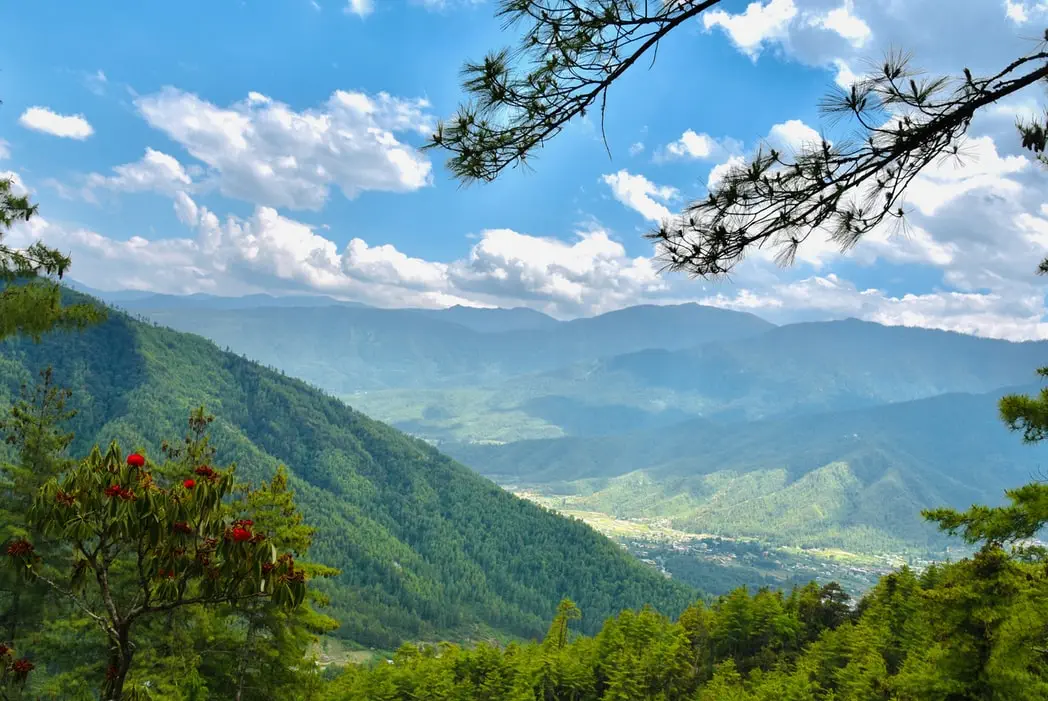
For now, Paro remains one of the best Bhutanese towns to explore on foot!
Paro Dzong
Paro Dzong or Rinpung Dzong ranks high point of Bhutanese architecture. The dzong is built on the edge of a steep hillside overlooking the Paro valley and Paro Chhu river.
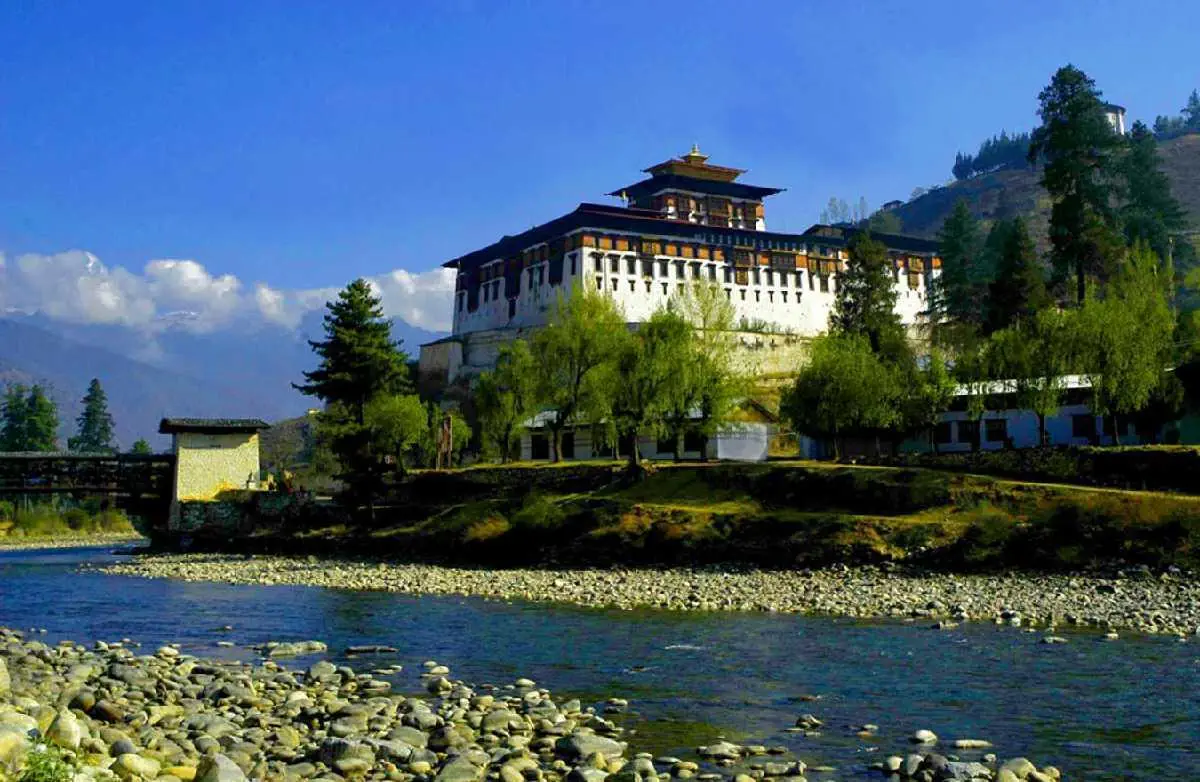
Don’t miss to visit the courtyards of this massive dzong.
You can end your day a little early and relax. Shop around and enjoy traditional Bhutanese food.
PRO TIPS
If time permits and if it interests you, add the following places to your itinerary:
National Museum
This former fortress was turned into a museum in 1968. The unusual round building is said to be of a conch shell. The displays include impressive collections of thangkas, both modern and ancient, depicting Bhutan’s important saints and teachers.
Jangsta Dumtse Lhakhang
One of the wonderful Buddhist monasteries in Paro, located upon the hills with a great view of Paro.
DAY 6 OF BHUTAN ITINERARY
PARO
The Tiger’s Nest
Here comes the grand finale to your Bhutan itinerary, “Taktshang Goemba”, also known as “Tiger’s Nest Monastery”.
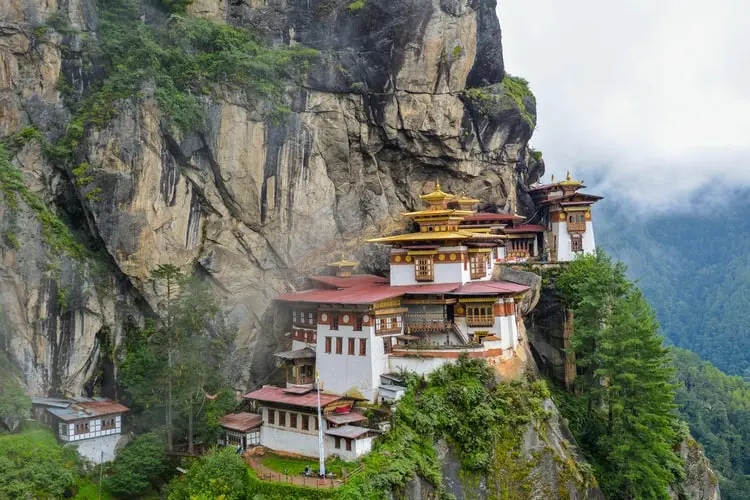
This most photogenic monastery, hanging onto what looks like a sheer vertical cliff, is the most popular place in Paro.
The site has been recognized as a holy place. It is believed that Guru Rinpoche flew to the site on the back of a tigress to subdue the local demon. Subsequently, he meditated in a cave for three months.
The only way to reach up to the Tiger’s Nest is to walk or ride a horse. The 1.5-2 hour hike is a central part of every itinerary and is unmissable for its stunning views!
Hot-Stone Water Bath
You can ask your guide to arrange for a Bhutanese hot-stone bath. This is available in most tourist hotels (for a charge). The best time for this bath is right after the Tiger Nest hiking. This therapeutic bath will rejuvenate you for sure!
End your day in Paro with wonderful dinner.
PRO TIPS
Off Beaten Track: To get off the beaten path, add an overnight trip to Haa Valley. The isolated Haa Valley is a hidden gem of Bhutan.

As a matter of fact, less than 10% of visitors make it to Haa! However, its picturesque valley makes it ideal for hiking and mountain biking!
DAY 7 OF BHUTAN ITINERARY
Today, begin your journey back home! Bid adieu to Bhutan with lots of good memories!
You can either fly back to India from Paro or head back to Bagdogra. If you are driving back to Bagdogra, you may want to add one more day to your itinerary, as you’ll halt at Pheuntsholing. The duration from Paro to Pheuntsholing is 5 hours and Pheuntsholing to Bagdogra is another 4 hours.
BEST TIME TO VISIT BHUTAN
Bhutan has five seasons – spring, summer, winter, autumn and monsoon.
Summer months from April to mid-June are a peak season for tourism.
We recommend travelling from October to March.
DO INDIAN’S NEED A VISA TO ENTER BHUTAN?
No. Indian tourist visiting Bhutan does not require any visa. Hoever, they do need a travel PERMIT.
There are 2 types of PERMIT:
Entry Permit: This can be procured at the entry point either at Paro airport (when travelling by flight) or in Phuentsholing, Bhutan (when travelling overland from Bagdogra or NJP station).
This permit is made by physically being present. This is a valid document to visit Thimphu and Paro.
Inner Line Permit (ILP): Remember, Entry Permit is valid for travel up to or within Thimphu and Paro District. Therefore, if you wish to visit places that go beyond Thimphu and Paro district, you will need ILP. For more details on permits, click here.
You can take help of local tour operators or do it by yourself.
ENTRY FEES FOR INDIANS
The Bhutan government has drafted a policy, imposing an entry fee of Rs 1200 per day, per person on tourists from India, Bangladesh and Maldives. However, the same has not been finalized and is under discussion.
Hope you guys enjoyed reading the Bhutan Itinerary. If you have any queries, leave a comment or drop me an email to alawyersvoage@gmail.com
If you like this itinerary please share, as sharing is caring! 🙂
Also, please follow us on Instagram for some wonderful wanderlust vibes!


